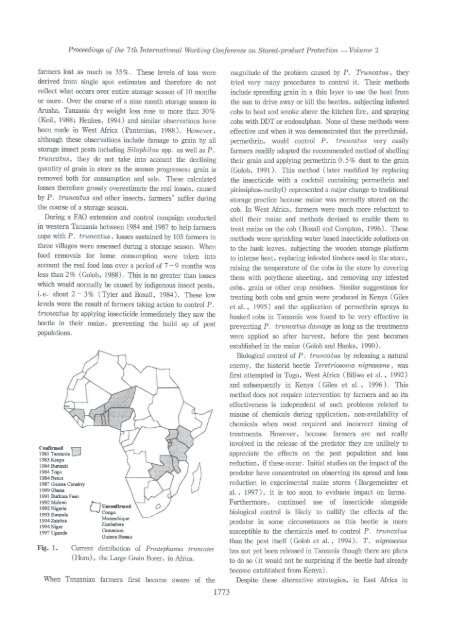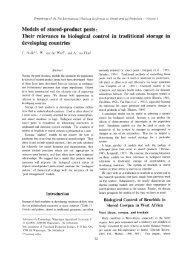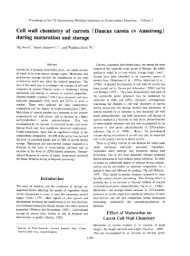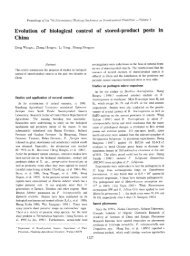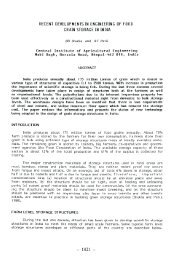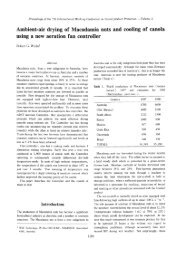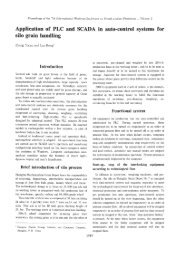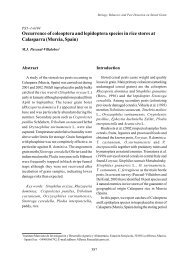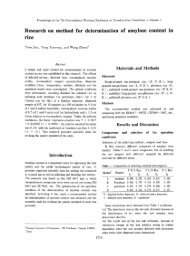Coping strategies employed by farmers against the larger grain ...
Coping strategies employed by farmers against the larger grain ...
Coping strategies employed by farmers against the larger grain ...
Create successful ePaper yourself
Turn your PDF publications into a flip-book with our unique Google optimized e-Paper software.
Proceedings of<strong>the</strong> 7 th Iniernaiumal. Worki.ng Conference on Storedrproduct Protection. - Volump 2<br />
<strong>farmers</strong> lost as much as 35 %. These levels of loss were magnitude of <strong>the</strong> problem caused <strong>by</strong> P. Truncatus , <strong>the</strong>y<br />
derived from single spot estimates and <strong>the</strong>refore do not tried very many procedures to control it. Their methods<br />
reflect what occurs over entire storage season of 10 months include spreading <strong>grain</strong> in a thin layer to use <strong>the</strong> heat from<br />
or more. Over <strong>the</strong> course of a nine month storage season in <strong>the</strong> sun to drive away or kill <strong>the</strong> beetles, subjecting infested<br />
Arusha, Tanzania dry weight loss rose to more than 30 % cobs to heat and smoke above <strong>the</strong> kitchen fire, and spraying<br />
(Keil, 1988; Henkes, 1994) and similar observations have cobs with DDT or endosulphan, None of <strong>the</strong>se methods were<br />
been made in West Africa (Pantenius, 1988). However, effective and when it was demonstrated that <strong>the</strong> pyrethroid ,<br />
although <strong>the</strong>se observations include damage to <strong>grain</strong> <strong>by</strong> all permethrin, would control P. truncaius very easily<br />
storage insect pests including Sitophilus spp. as well as P. <strong>farmers</strong> readily adopted <strong>the</strong> recommended method of shelling<br />
truncatus, <strong>the</strong>y do not take into account <strong>the</strong> declining <strong>the</strong>ir <strong>grain</strong> and applying permethrin 0.5 % dust to <strong>the</strong> <strong>grain</strong><br />
quantity of <strong>grain</strong> in store as <strong>the</strong> season progresses; <strong>grain</strong> is (Golob, 1991). This method (later modified <strong>by</strong> replacing<br />
removed both for consumption and sale. These calculated <strong>the</strong> insecticide with a cocktail containing permethrin and<br />
losses <strong>the</strong>refore grossly overestimate <strong>the</strong> real losses, caused pirimiphos-methyl) represented a major change to traditional<br />
<strong>by</strong> P. truncatu.s and o<strong>the</strong>r insects, <strong>farmers</strong>' suffer during storage practice because maize was normally stored on <strong>the</strong><br />
<strong>the</strong> course of a storage season.<br />
cob. In West Africa, <strong>farmers</strong> were much more reluctant to<br />
During a FAO extension and control campaign conducted shell <strong>the</strong>ir maize and methods devised to enable <strong>the</strong>m to<br />
in western Tanzania between 1984 and 1987 to help <strong>farmers</strong> treat maize on <strong>the</strong> cob (Boxall and Compton, 1996). These<br />
cope with P. iruruxtiu«, losses sustained <strong>by</strong> 105 <strong>farmers</strong> in methods were sprinkling water based insecticide solutions on<br />
three villages were assessed during a storage season. When to <strong>the</strong> husk leaves, subjecting <strong>the</strong> wooden storage platform<br />
food removals for home consumption were taken into to intense heat, replacing infested timbers used in <strong>the</strong> store,<br />
account <strong>the</strong> real food loss over a period of 7- 9months was raising <strong>the</strong> temperature of <strong>the</strong> cobs in <strong>the</strong> store <strong>by</strong> covering<br />
less than 2% (Golob, 1988). This is no greater than losses <strong>the</strong>m with poly<strong>the</strong>ne sheeting, and removing any infested<br />
which would normally be caused <strong>by</strong> indigenous insect pests,<br />
i.e. about 2- 3% (Tyler and Boxall, 1984). These low<br />
levels were <strong>the</strong> result of <strong>farmers</strong> taking action to control P.<br />
cobs, <strong>grain</strong> or o<strong>the</strong>r crop residues. Similar suggestions for<br />
treating both cobs and <strong>grain</strong> were produced in Kenya (Giles<br />
et ai., 1995) and <strong>the</strong> application of permethrin sprays to<br />
trurwatus <strong>by</strong> applying insecticide immediately <strong>the</strong>y saw <strong>the</strong><br />
beetle in <strong>the</strong>ir maize, preventing <strong>the</strong> build up of pest<br />
populations.<br />
husked cobs in Tanzania was found to be very effective in<br />
preventing P. truncaius danwge as long as <strong>the</strong> treatments<br />
were applied so after harvest, before <strong>the</strong> pest becomes<br />
established in <strong>the</strong> maize (Golob and Hanks, 1990).<br />
Biological control of P. truncatue <strong>by</strong> releasing a natural<br />
enemy, <strong>the</strong> histerid beetle TeTetriosmna niqreecens , was<br />
first attempted in Togo, West Africa (Biliwa et al. , 1992)<br />
and subsequently in Kenya (Giles et aI., 1996). This<br />
method does not require intervention <strong>by</strong> <strong>farmers</strong> and so its<br />
effectiveness is independent of such problems related to<br />
misuse of chemicals during application, non-availability of<br />
chemicals when most required and incorrect timing of<br />
treatments. However, because <strong>farmers</strong> are not really<br />
involved in <strong>the</strong> release of <strong>the</strong> predator <strong>the</strong>y are unlikely to<br />
C'oDfirmed ~<br />
1981 TlIJlZA1J.ia~<br />
appreciate <strong>the</strong> effects on tile pest population and loss<br />
198.~Kenya<br />
19MBurundi<br />
reduction, if <strong>the</strong>se occur. Initial studies on <strong>the</strong> impact of <strong>the</strong><br />
1~4 Togo<br />
1984 Benin<br />
1987 Guinea Conakry<br />
predator have concentrated on observing its spread and loss<br />
reduction in experimental maize stores (Borgemeister et<br />
19890hana<br />
1991 Burkina Fesc<br />
1992 Malawi<br />
1992 Nigeria<br />
1993 Rwanda<br />
1994 Zambia<br />
1994 Niger<br />
1997 Uganda<br />
h UKQld'irmed<br />
LJCongo<br />
Mozambique<br />
Zimbabwe<br />
Cemercon<br />
Guinea Bissau<br />
aI., 1997), it is too soon to evaluate impact on farms.<br />
Fur<strong>the</strong>rmore, continued use of insecticide alongside<br />
biological control is likely to nullify <strong>the</strong> effects of <strong>the</strong><br />
predator in some circumstances as this beetie is more<br />
susceptible to <strong>the</strong> chemicals used to control P. truncatu«<br />
than <strong>the</strong> pest itself (Golob et aI., 1994). T. nigrescens<br />
Fig. 1. Current distribution of Prostephanus truncates has not yet been released in Tanzania though <strong>the</strong>re are plans<br />
(Hom), <strong>the</strong> Large Grain Borer, in Africa. to do so Cit would not be surprising if <strong>the</strong> beetle had already<br />
become established from Kenya).<br />
When Tanzanian <strong>farmers</strong> first became aware of <strong>the</strong><br />
1773<br />
Despite <strong>the</strong>se alternative <strong>strategies</strong>, in East Africa in


